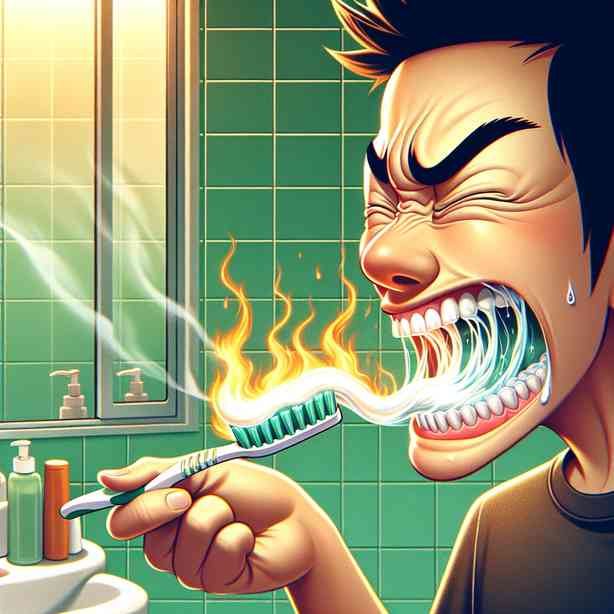
Toothpaste is an essential part of our daily oral hygiene routine, a product we often take for granted. However, many people experience a burning sensation while brushing their teeth, leading them to wonder whether their toothpaste is more of a hindrance than a help. Understanding why toothpaste might burn, what ingredients contribute to that sensation, and how to choose the right one can improve your oral health and enhance your brushing experience.
First and foremost, it’s essential to recognize the primary purpose of toothpaste. Its main function is to clean the teeth, remove plaque, and prevent cavities. Most toothpastes contain abrasive agents that help scrub away food particles and stains, while fluoride strengthens the enamel. However, not all toothpastes are created equal, and the discomfort some individuals experience can often be traced back to specific ingredients.
One of the most common culprits for the burning sensation is mint flavoring, widely used in toothpaste for its refreshing taste and breath-freshening properties. While many people enjoy the tingling sensation that mint offers, those with sensitive gums or oral tissues may find it irritating. If you generally have a sensitive mouth, consider switching to a non-mint flavored toothpaste. Many brands offer alternatives using flavors like vanilla or fruit that can maintain oral health without causing discomfort.
Another possible cause of toothpaste irritation is the presence of certain chemicals, such as sodium lauryl sulfate (SLS). SLS is a foaming agent found in many cosmetic products, including toothpaste. While it helps create the bubbly texture we often associate with cleaning, it can be abrasive and irritating to some individuals, especially those with pre-existing oral conditions. If you notice burning or sensitivity, look for SLS-free toothpaste options, which are designed specifically for sensitive mouths and can provide a gentler experience.
Furthermore, whitening toothpastes can also lead to an unpleasant burning sensation. These products often contain abrasive ingredients or harsh chemicals that can potentially lead to increased sensitivity in some individuals. While the desire for whiter teeth is understandable, it is crucial to balance that with comfort. If you’re seeking whiter teeth but are experiencing discomfort, consult with your dentist about alternative whitening options that may be less abrasive.
Toothpaste for sensitivity is another category worth exploring. Many brands offer specially formulated toothpastes designed for individuals with sensitive teeth or gums. These toothpastes often contain potassium nitrate or strontium chloride, which work to soothe nerve endings in the teeth and reduce the sensation of pain and discomfort. If you’ve dealt with burning during brushing, trying a sensitivity toothpaste may alleviate your symptoms while keeping your mouth healthy.
Additionally, pay attention to your brushing technique. Even the best toothpaste won’t mitigate discomfort if you are brushing too hard or using a hard-bristled toothbrush. Gentle, circular motions with a soft-bristled toothbrush are recommended to minimize trauma to your gums and enamel. It’s also a good idea to replace your toothbrush every three to four months or sooner if the bristles are frayed. Using a worn-out toothbrush can lead to ineffective cleaning and potential gum irritation.
Another factor that could contribute to your discomfort is the amount of toothpaste you are using. Many people apply too much toothpaste, leading to excessive foaming and resulting irritation. A pea-sized amount is generally sufficient for effective cleaning. Using less paste can reduce the burning sensation while still keeping your teeth clean.
In addition to toothpaste, consider other factors affecting your oral health, such as diet. Some foods and beverages can contribute to a burning sensation, either due to their acidity or spiciness. If you frequently consume highly acidic foods like citrus fruits or carbonated drinks, you may want to take a break from them, as they can exacerbate tooth sensitivity or gum irritation. Regular professional cleanings and check-ups can also help you identify any underlying issues causing discomfort.
It’s important to note that if the burning sensation persists despite switching toothpaste or modifying your brushing technique, it could be indicative of a more serious underlying condition. Conditions like gum disease, oral infections, or even allergic reactions can manifest as discomfort during brushing. In such cases, it’s advisable to consult with a dental professional to rule out any significant issues.
Ultimately, while toothpaste is designed to improve oral health, it’s essential to select the right product for your needs. If your toothpaste burns more than it helps, it may be time to change your approach. By being mindful of your oral health, choosing the right toothpaste, and adopting proper brushing techniques, you can ensure a more comfortable and effective brushing experience.
In summary, if you’re facing a burning sensation while brushing, don’t despair; solutions are readily available. Experiment with different flossing techniques, consider opting for non-mint or SLS-free options, and always consult your dentist for personalized recommendations. Your oral health is crucial, and with the right toothpaste and techniques, you can make brushing a pleasant and satisfying part of your daily routine. Remember that taking care of your mouth is a significant investment in your overall health, and with a little trial and error, you can find the perfect balance for your needs.


